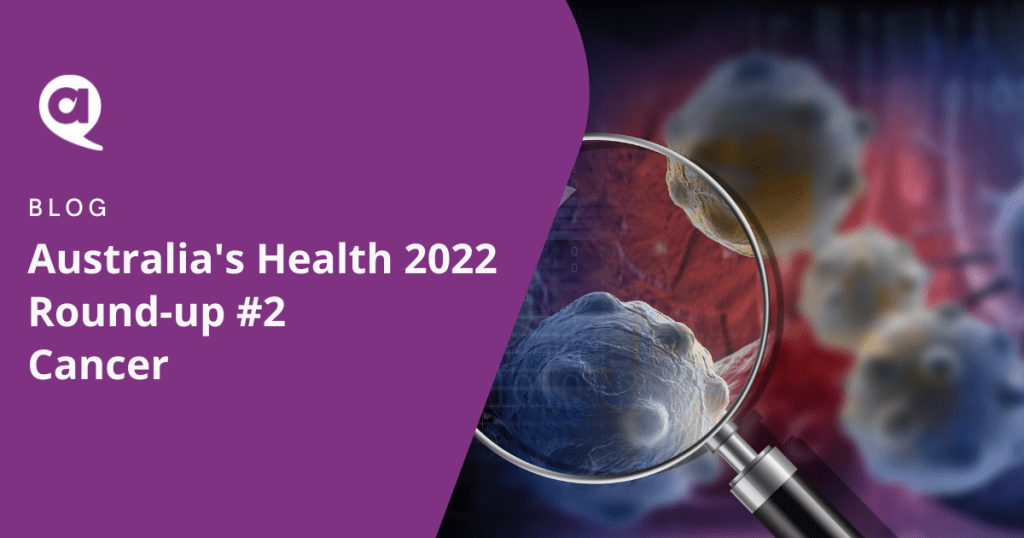
August 2022
By the ACHPER NSW Professional Learning Team
The Australian Institute of Health and Welfare (AIHW) has released Australia’s Health 2022. ACHPER NSW has compiled a series of top-level highlights with teaching notes.
Round-up #2 below looks at the latest trends for Cancer.
Previous round-ups:
– Round-up 1: Morbidity and mortality
Cancer – nature of the disease
Cancer is a large range of diseases in which some of the body’s cells become defective, begin to multiply out of control, can invade and damage the area around them, and can also spread to other parts of the body to cause further damage.
Teaching note:
Past HSC multiple choice have expected students to know the different types of cancers e.g. carcinoma
Extent of the problem
- There are more than 1 million people alive in Australia who have previously been diagnosed with cancer.
- During 1989–1993, 5 in 10 (52%) people survived for at least 5 years after their cancer diagnosis.
- By 2014–2018 survival had increased to 7 in 10 (70%) people surviving at least 5 years.
In 2011:
- Most cancers were diagnosed at stage I or II (66%), with melanoma of the skin having the highest percentage diagnosed at stage I (78%).
- 12% of cases diagnosed with one of the 5 most commonly diagnosed cancers presented with a stage IV cancer.
- Stage IV cancer accounted for 42% of lung cancers diagnosed, which was the highest percentage of the 5 most commonly diagnosed cancers (breast, prostate, colorectal and lung cancers and melanoma of the skin).
In 2022, it is estimated that:
- About 162,000 new cases of cancer were diagnosed in Australia, an average of over 440 every day;
- More than half (55%) of these cases were diagnosed in males.
The most commonly diagnosed cancers in males were:
- prostate cancer (24,217 cases),
- melanoma of the skin (10,374 cases)
- colorectal cancer (8,300 cases)
- lung cancer (7,707 cases).
The most commonly diagnosed cancers in females were:
- breast cancer (20,428 cases)
- colorectal cancer (7,413 cases)
- melanoma of the skin (7,382 cases)
- lung cancer (6,822 cases).
Impact of COVID 19
COVID-19 restrictions appear to have affected the uptake of breast ultrasound, mammography, breast magnetic resonance imaging and colonoscopy.
Teaching note:
Analyse with students what this means in terms of the potential trends in morbidity and mortality rates and how this information links to identifying priority health issues.
Socio-economic factors
During 2012–2016, the age-standardised incidence rate for all cancers combined was:
- highest for those living in the 2 lowest socioeconomic areas
- lowest for those living in the 2 highest socioeconomic areas.
Age-standardised incidence rates tend to increase with increasing disadvantage for the following cancers:
- colorectal cancer (from 52 in the least disadvantaged areas to 61 cases per 100,000 people in the most disadvantaged areas)
- lung cancer (from 31 to 55 cases per 100,000 people)
- head and neck cancer (including lip) (from 14 to 21 cases per 100,000 people)
- kidney cancer (from 11 to 15 cases per 100,000 people)
- pancreatic cancer (from 11 to 13 cases per 100,000 people)
- cancer of unknown primary site (from 7.2 to 11 cases per 100,000 people)
- liver cancer (from 5.9 to 9.4 cases per 100,000 people)
- cervical cancer (from 5.9 to 8.8 cases per 100,000 females)
- uterine cancer (from 17 cases to 20 per 100,000 females).
In contrast, the age-standardised incidence rates tended to decrease with increasing disadvantage for the following cancers:
- breast cancer (from 138 in the least disadvantaged areas to 117 cases per 100,000 females in the most disadvantaged areas)
- prostate cancer (from 169 to 137 cases per 100,000 males).
Compared with people living in the least socioeconomically disadvantaged areas:
- cancer incidence rates for people living in the most disadvantaged areas were 5% higher
- 5-year observed survival rates were around 12 percentage points lower (56% compared to 68%)
- Cancer mortality rates were over 40% higher.
Teaching note:
Discuss with students the reasons they think that some cancers increase with higher disadvantage. Link to risk and protective factors as well as social determinants.
Groups at risk
Aged
The Australian population is ageing, and the risk of being diagnosed with cancer increases with age. With more Australians living to older ages, the number of cancer cases diagnosed each year continues to rise.
Teaching note:
Students can use AIHW interactive graphs to see cancer incidence, survival and mortality that includes age, gender and cancer site.
This information also links into other aspects of Core 1 – Health Priorities in Australia such as:
- Focus question 1 – morbidity and mortality rates
- Focus question 2 – e.g. how does the information on mortality and morbidity rates link. The growing and ageing population means more diagnosis (extent of the problem) which leads to greater demand for health services and workforce shortages
- Focus question 3 – e.g. as demand for health services increases health care expenditures versus expenditure on early intervention and prevention, impact of emerging technologies and equity of access to a range and type of health facilities and services – what is the data telling us?
- Focus question 4 – we know which group is a risk and what they are at risk of. How does this link to Health Promotion?
Indigenous Australians
In the period 2012–2016, an average of 1,665 cases of cancer were diagnosed among Indigenous Australian per year (in New South Wales, Victoria, Queensland, Western Australia and Northern Territory).
The age-standardised incidence rate for all cancers combined was 14% higher for Indigenous Australians than non-Indigenous Australians.
For the 2012–2016 period:
- Prostate cancer was the most common cancer diagnosis in Indigenous males (on average, 141 cases per year).
- Breast cancer was the most common cancer diagnosis in Indigenous females (on average, 205 cases per year).
- Lung cancer was the most common cancer diagnosis for Indigenous Australians overall and the second most common cancer diagnosis for each sex (on average, 125 cases per year for males and 119 cases per year for females).
Teaching note:
Students should be able to analyse the overall data and look at the relationship between demographics, diagnoses and preventable chronic diseases and discuss the implications.
Overall teaching note
There is potential for a holistic approach to teaching Core 1 by asking students to explore CVD or Cancer through each of the health topic summaries on the AIHW website. This would give them an overview of how all the information links together to establish Health Priorities in Australia.
The Stage 6 syllabus asks students to analyse general current trends and compare males and females e.g increasing, decreasing or remains the same. Students do not need to know specific statistics. They will also need to provide potential reasons for these trends
Current trends
Morbidity
Age-standardised incidence rates – male cases per 100,000
Cancer | 1982 | Rank | 2002 | Rank | 2022 Est. | Rank | Overall Trend |
Lung | 85.1 | 1 | 61.4 | 4 | 48.5 | 4 | Decrease |
Prostate | 79.8 | 2 | 137.7 | 1 | 150.8 | 1 | Increase |
Colorectal | 66.7 | 3 | 76.6 | 2 | 54.5 | 3 | Decrease (Rank increase) |
Melanoma | 27.9 | 4 | 60.7 | 3 | 68.7 | 2 | Increase |
Age-standardised incidence rates – female cases per 100,000
Cancer | 1982 | Rank | 1992 | Rank | 2022 Est. | Rank | Overall Trend |
Breast | 81.2 | 1 | 118.6 | 1 | 131.1 | 1 | Increase |
Colorectal | 52.2 | 2 | 52.6 | 2 | 43.7 | 2 | Increase |
Melanoma | 26.3 | 3 | 41.5 | 3 | 46.6 | 3 | Increase |
Lung | 18.2 | 4 | 29.4 | 4 | 38.9 | 4 | Increase |
Teaching note:
Students can manipulate this table themselves for different ages/date ranges – Cancer rankings data. They could also create their own graph with the data.
Australian Institute of Health and Welfare. (2022). Cancer data in Australia. Retrieved from https://www.aihw.gov.au/reports/cancer/cancer-data-in-australia
Mortality
The following trend data has been drawn from Annual Mortality Rate 1968 – 2019 – https://ncci.canceraustralia.gov.au/outcomes/cancer-mortality/cancer-mortality
Gender | Cancer | Trend |
Male | Lung | Relatively stable for last 20 years |
Prostate | Increasing | |
Colorectal | Relatively stable | |
Melanoma | Rising since 2016. | |
Female | Breast | Increase |
Colorectal | Relatively stable | |
Melanoma | Decreasing since 2017. | |
Lung | Increasing |


